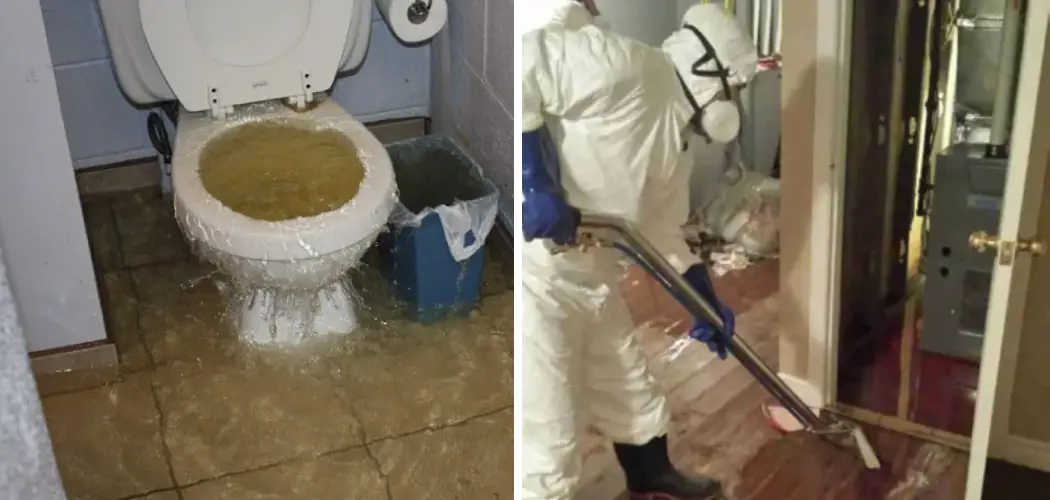Are you dealing with the aftermath of a nasty sewer backup in your home or workplace? It’s an unfortunate situation, but there are effective steps you can take to ensure your safety and sanitation. We’ll be discussing how to sanitize after a Sewer Backup so that you and your family can experience some peace of mind during this difficult time.
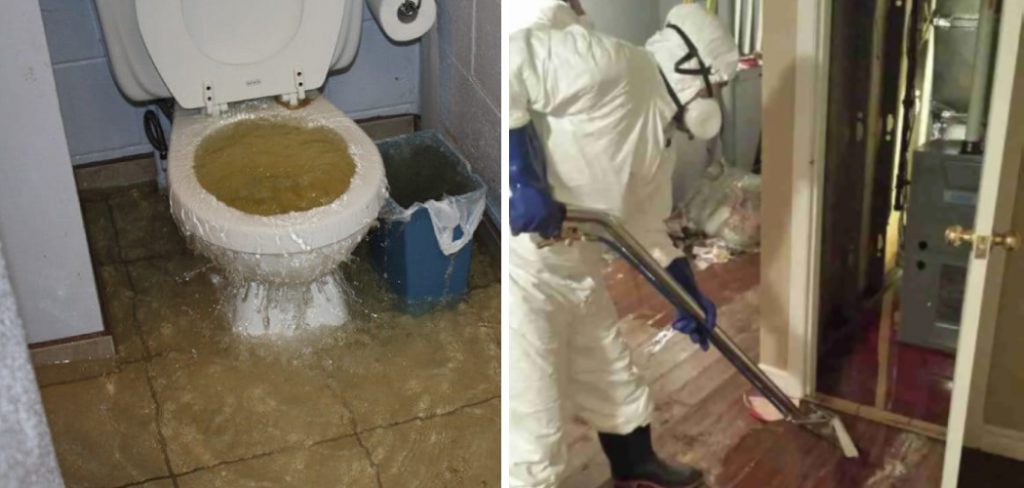
From decontaminating furniture, floors, wall coverings and other items within the affected area to preventing any further contamination from air ducts or ventilation systems, we’ll walk through all the necessary steps on how to sanitize after sewer backup that need to be taken for proper sanitation. With our advice –and a little elbow grease —you’ll have everything under control in no time!
Needed Materials
To get started, gather the necessary materials for cleaning and disinfecting. You will need:
- Rubber Gloves
- Face Mask
- Protective Eyewear
- Disinfectant Cleaner
- Bleach
- Large Garbage Bags
11 Step-by-step Guidelines on How to Sanitize After Sewer Backup
Step 1: Put on the Protective Gear
Before you begin any cleaning, make sure to protect yourself by wearing rubber gloves, a face mask, and protective eyewear. This will prevent any direct contact with contaminated materials and help reduce the risk of infection. You should also make sure to wash your hands thoroughly after removing the protective gear. But how do you sanitize after sewer backup if there are so many steps? Keep reading!
Step 2: Ventilate the Area
Start by opening all windows and doors to allow fresh air to circulate in the affected area. This will help reduce any unpleasant odors and improve air quality. You can also use fans to increase air circulation and dry out any wet areas. This is an important step in preventing mold growth. It’s essential to ventilate the area before beginning any cleaning or disinfecting.

Step 3: Remove and Discard Contaminated Items
Any items that cannot be properly sanitized, such as rugs, cushions, mattresses or other porous materials should be removed from the area and discarded in large garbage bags. This will help prevent further contamination and keep your home or workplace clean.
You may also need to remove any standing water or debris from the area using a wet vacuum or mop. Although it may be tempting to save these items, it’s best to dispose of them and focus on properly sanitizing the rest of the affected area.
Step 4: Clean Surfaces with Disinfectant Cleaner
Using a disinfectant cleaner and a clean cloth, start wiping down all surfaces within the affected area. Make sure to thoroughly clean any hard surfaces such as countertops, walls, and floors. Pay extra attention to areas that may have come into direct contact with the sewer backup. It’s important to use a cleaner specifically designed for disinfecting, as regular household cleaners may not be effective in killing harmful bacteria and viruses.
Step 5: Use Bleach for Sanitizing
Next, mix one cup of bleach with one gallon of warm water and use this solution to sanitize hard surfaces and non-porous materials. This powerful disinfectant will effectively kill any remaining bacteria and viruses in the affected area. Remember to always use bleach in a well-ventilated area and wear protective gear to avoid any potential harm.
Step 6: Decontaminate Furniture
Any furniture that has come into contact with the sewer backup should also be thoroughly cleaned and disinfected. Use a disinfectant cleaner or bleach solution to wipe down all surfaces, including any fabric or upholstery. If possible, remove any cushions or covers and wash them in hot water with bleach to ensure proper sanitation. This step is crucial in preventing the spread of harmful bacteria and viruses.
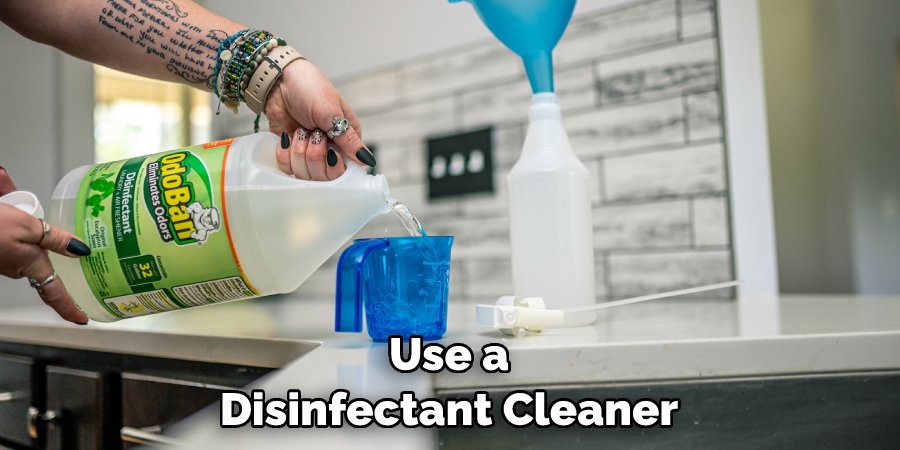
Step 7: Clean Air Ducts and Vents
Sewer backups can easily contaminate air ducts and ventilation systems, which can lead to further contamination of your home or workplace. It’s essential to clean and disinfect these areas using a specialized cleaner or bleach solution. This will help prevent any potential health hazards and ensure the air quality in your home or workplace is safe.
Step 8: Wash All Clothing and Linens
Any clothing, linens, or towels that have come into contact with the sewer backup should be washed separately in hot water with bleach. This will effectively kill any lingering bacteria and viruses. It’s important to wash these items separately from other laundry to avoid any potential cross-contamination. This is also a good idea to wash your hands thoroughly after handling these items.
Step 9: Sanitize Personal Items
Any personal items that may have come into contact with the sewer backup, such as toothbrushes, makeup brushes, or children’s toys should also be properly sanitized. Use a disinfectant cleaner or bleach solution to wipe down these items and then rinse them thoroughly with water. It’s important to take extra care with these items as they come into direct contact with your body.
Step 10: Dispose of Cleaning Materials
Once you have completed all the necessary cleaning and sanitizing, make sure to properly dispose of all used cleaning materials. This includes any rags, sponges, or mops that may have been in contact with the sewer backup. Bag them in a garbage bag and dispose of them properly to avoid any further contamination. That way, you can ensure a clean and sanitary environment.
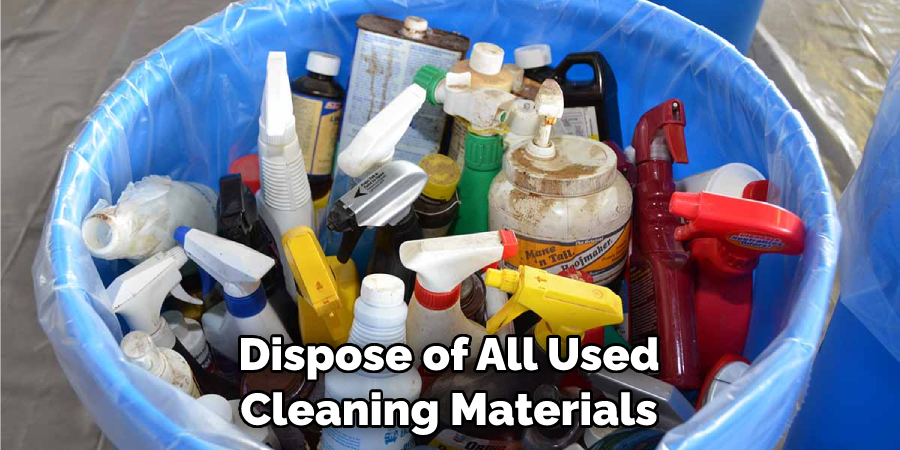
Step 11: Follow Up with Professional Services
In some cases, a sewer backup may require the expertise of professional services to properly clean and sanitize the affected area. If you find that the damage is too severe or if you are unsure about how to handle it yourself, contact a reputable cleaning company for assistance.
They have the necessary equipment and knowledge to fully sanitize and decontaminate the area, ensuring a safe and healthy environment for you and your family.
Following these 11 steps on how to sanitize after sewer backup will help you effectively sanitize after a sewer backup and ensure the safety and cleanliness of your home or workplace.Remember to always prioritize your health and safety by wearing protective gear and properly disposing of any contaminated materials. With proper sanitation, you can prevent the spread of harmful bacteria and viruses and restore your living space back to its clean and safe state.
Additional Tips
- Always Wear Protective Gear When Handling Contaminated Materials.
- Properly Ventilate the Affected Area Before Beginning Any Cleaning.
- Remove All Contaminated Items and Dispose of Them Properly.
- Thoroughly Clean All Surfaces with Disinfectant Cleaner and Bleach.
- Don’t Forget to Sanitize Furniture, Air Ducts, Clothing, and Personal Items.
- Properly Dispose of Used Cleaning Materials After the Process is Complete.
- Consider Seeking Professional Assistance if the Damage is Severe.
- Keep an Eye Out for Signs of Mold Growth Even After Sanitizing. If Mold is Present, Seek Professional Help for Proper Removal.
Frequently Asked Questions:
Q1: Can I Save Any Items That Have Come Into Contact With the Sewer Backup?
A1: It’s best to dispose of any items that have come into direct contact with the sewer backup. Saving them may lead to further contamination and potential health hazards.
Q2: How Can I Tell if the Area is Properly Sanitized?
A2: The area should have a clean and fresh scent, and all surfaces should be visibly clean. If in doubt, you can use a test kit to check for any remaining bacteria or viruses. You can also seek professional assistance for a thorough check and confirmation.
Q3: What Should I Do if the Damage is Too Severe for Me to Handle?
A3: In such cases, it’s recommended to seek professional assistance. They have the necessary equipment and expertise to properly handle and sanitize the affected area. It’s important to prioritize your health and safety in such situations.
Q4: How Can I Prevent a Sewer Backup in the Future?
A4: Regular maintenance of your plumbing system is crucial in preventing sewer backups. Make sure to regularly clean and inspect your pipes, and avoid disposing of any items that may clog them. If you notice any issues, contact a professional plumber for assistance.
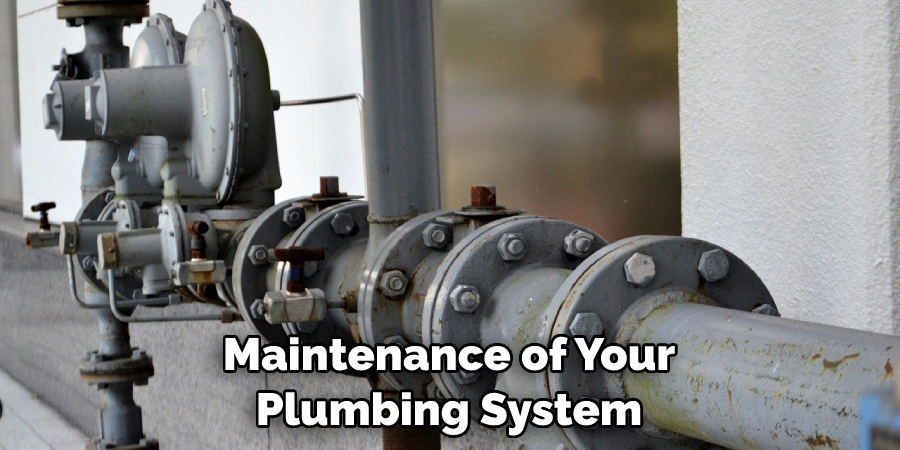
Conclusion
As you can see, there are several steps to take to ensure your safety and security after a sewer backup. Taking the proper precautions on how to sanitize after sewer backup, and following a consistent clean-up process can help keep you and your family safe from any potential harm.
Don’t forget to call an expert if your system is dealing with clogs, as this could be the cause of recurring backups. Doing regular maintenance on your system will also do wonders in keeping extra water from entering your home or office.
Finally, don’t underestimate the power of good bacteria – getting rid of all the germs right away is essential for every part of the sanitization process. Now that you know how to properly sanitize after a sewer backup, it’s time to take action! Make sure you gather all necessary supplies before beginning one yourself (or call an expert for help!), and always practice caution as you put these strategies into place.

